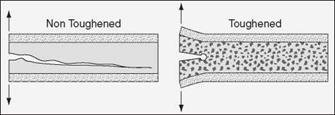Two-part acrylics are available either as two-part resins or as a resin for Part A with Part B as a liquid activator. The two-part resin products are formulated with Part A and Part B of similar viscosities and designed to be dispensed as bead-on-bead or mix-in-the-nozzle.
Two-part acrylics (also referred to as methyl methacrylates or methylmethacrylates (MMA)) can offer benefits over cyanoacrylates with improved gap fill and typically
improved durability on metals. Many different grades are available and some are more suited for metals than plastics although they do not give good performance on elastomers, fluoropolymers or polyolefins. There is also a risk that they may stress crack certain thermoplastics (especially the liquid activators) and care is required to ensure that the solvent-based liquid activator is applied to the least susceptible surface. The MMA products are differentiated from other two-part adhesive systems like epoxies or polyurethanes by the fact that the cure is relatively insensitive to the mix ratio.
They are comparatively inexpensive and although earlier versions were brittle when cured, the more recent developments are significantly tougher and more flexible generally give improved peel strength over cyanoacrylates.
The mix-in-the-nozzle grades can cure in less than 60 seconds although more typically the cure time is 5-15 minutes to handling strength and 12-24 hours to full strength. Some grades of MMA give outstanding performance on unprepared or oily steel with fixture times of about 10 minutes. They will also withstand a paint bake cycle (and benefit from the heat cure) and so are used in some sheet metal industries to replace rivets.
Some toughened acrylic grades can be difficult to dispense due to the ‘stringiness’ of the additives in the adhesive matrix and so difficult to manage on small component parts. They often have a high odour (although low-odour versions are available) and some acrylics are flammable.
The MMA are usually toughened with rubber dissolved in the monomer (Figure 1.22) and it is these rubber particles that provide the high peel strength and toughness.
MMA have proved to be extremely useful in the bonding of larger plastic components such as bonding automotive bumpers, fibreglass components and assembling boats.
A more recent development in MMA technology are products that will bond polyolefin plastics successfully (see Section 6.4).
|
|
 8 сентября, 2015
8 сентября, 2015  Pokraskin
Pokraskin 
 Опубликовано в рубрике
Опубликовано в рубрике 